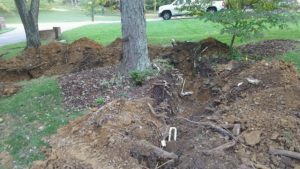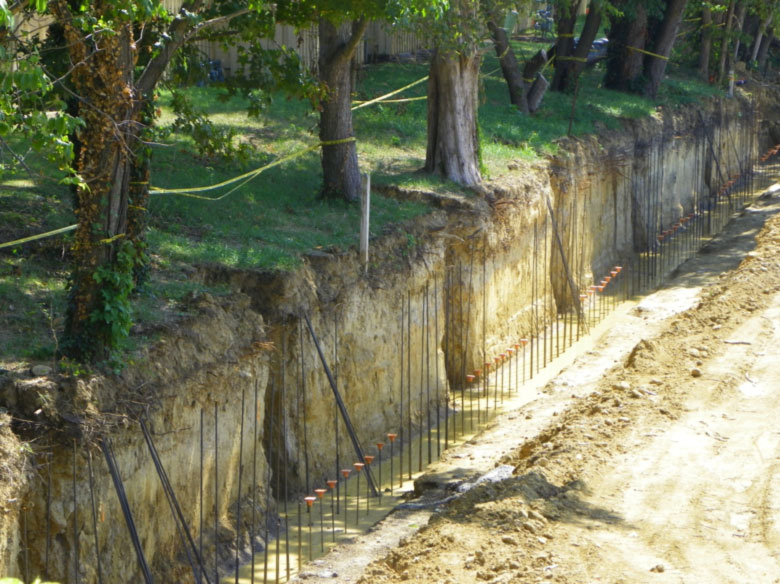
Digging/trenching around trees to install utilities severs their roots. The amount of damage depends on proximity to the trunk and area of root development.
Updated on July 11, 2019. Nashville’s housing construction scene is still booming! For years we observed many construction companies pulverizing the root systems of trees, leaving new homeowners with damaged, dying and dead trees to contend with. Two to three years post-construction, we receive calls about mature trees starting to show signs of decline that we can directly attribute to construction damage. It’s not always easy to save trees during construction, but any efforts you make to protect your trees are worth the trouble.
According to the Council of Tree and Landscape Appraisers, a mature tree can often have an appraised value of between $1,000 and $10,000. Furthermore, Management Information Services/ICMA state that landscaping, especially with trees, can increase property values as much as 20 percent. By implementing a protection plan prior to construction, you can lessen the devastating impact to existing trees on your property.
COMPACTION – the “SILENT KILLER.” While broken branches are commonplace on a construction site, damage done underground is even worse. Approximately 90-95 percent of a tree’s root system is in the top three feet of soil and more than half of its root system is in the top one foot of soil. The most critical roots are the non-woody roots called “feeder roots” that reside in the first 6 inches of soil. They are so close to the surface they compete with grass roots for water and nutrients. When the soil is compacted from heavy equipment repeatedly passing over, and even more exacerbated when the soil is wet, the most damage can be done. Before starting any construction project, call an arborist to help you take inventory of which trees to save and take the appropriate measures to protect your trees. Take good notes and photos for your records.
PREPARE. Make sure the trees you want to preserve are healthy before construction begins! First, trees should be receiving the right amount of water and fertilizer. Second, spread two to four inches of mulch (wood chips or bark), over as much of the root system as practical, to help the tree retain water and stimulate root regeneration.
MARK BOUNDARIES. The part of the root system in which construction damage should be avoided is called the Protected Root Zone (PRZ). One common method used to identify the PRZ is to define it as the “dripline”– the area directly below the branches of the tree. For an extra measure of protection, extend the protection zone beyond the dripline as much as possible.
COMMUNICATE WITH YOUR BUILDER. Ask your builder to mark the areas where heavy equipment will be used and where mounds of sand and building materials will be stored. Show your builder the boundaries that are marked and explain how important it is they adhere to these boundaries. Soil compaction is the single most reason that urban trees die and shockingly, many construction companies don’t seem to understand this fact. Finally, decide if any trees will need the canopy to be raised to accommodate construction equipment. Have your arborist discuss with the builder and remove limbs prior to construction — it is much better to remove a limb the right way than risk injuring the tree in the midst of construction.
MONITOR THE PROCESS. Make sure that any accidental damage to your trees during construction is repaired quickly. Root injury may show decline in a few months or several years. Look for signs of leaf wilt, early fall coloring, water sprouts, top dieback and slow growth. Aeration and vertical mulching post-construction can benefit any compacted areas.
Full Circle Tree and Shrub is committed to preserving and enhancing the quality of your property through tree care education and services. Jeff Bergman, our owner and certified arborist, is available for a consultation prior to any construction project. If you have any questions or need additional information regarding the health of your trees, please contact us.

Trench dug up to the base of trees. Trench is approximately 15 feet deep. Copyright © 2005 Purdue University.
Additional sources:
- https://www.nashville.gov/Codes-Administration/Land-Use-and-Zoning-Information/Urban-Forestry/Tree-Protection-During-Construction.aspx
- http://www.extension.umn.edu/garden/yard-garden/trees-shrubs/protecting-trees-from-construction-damage/
- https://www.arborday.org/programs/graphics/conservation-trees/save-trees-during-construction.pdf

